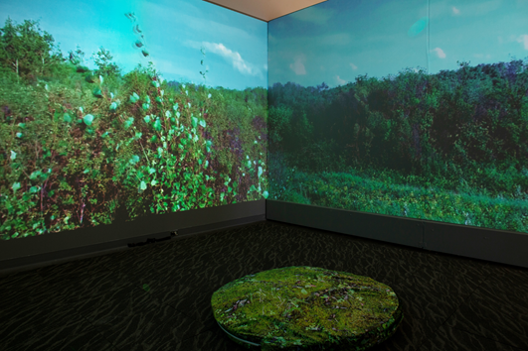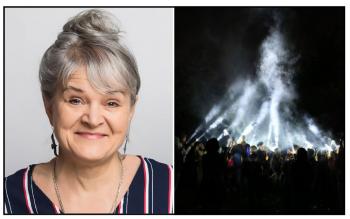Image Caption
Summary
Local Journalism Initiative Reporter
Windspeaker.com
Cheryl L'Hirondelle’s work as an interdisciplinary artist has taken on several forms—song, virtual reality, audiovisual and interactive experiences—during her career spanning five decades.
L'Hirondelle said she was simply following in the footsteps of what she saw her relatives doing.
“I come from a large half-breed family,” she said, born to a German-born father and a Métis/Cree mother from Papaschase First Nation in Alberta. “All of my aunts and uncles are musicians…Everyone in my whole childhood was always about having some creative abilities and skills. I wanted to be a veterinarian, originally, but maybe I wasn’t that great at science.”
L'Hirondelle was recently named as one of the recipients of the 2021 Governor General’s Awards for the Visual and Media Arts presented by the Canada Council for the Arts. She said the news brought her to tears.
“It was such an honour to be recognized by my peers and the larger art community,” she said.
L’Hirondelle’s career is a decorated one. She’s the recipient of two imagineNATIVE New Media Awards (2005, 2006), and two Canadian Aboriginal Music Awards (2006, 2007).
She’s currently studying for her PhD remotely through the University College Dublin in Ireland, and like in much of her work, her studies focus on Indigenous language preservation and education.
“We forget that as Native people we have the right to be self-determining, and that means even the way we speak, the way we want to be understood, represented,” L’Hirondelle said. “It behooves us to continue to use our language as much as possible. Our language is connected to our land. I always try to introduce myself as being from ‘The land now known as Canada.”
“If we can even say a few words in our language, I think that’s really important,” she added.
L'Hirondelle says her PhD research has been a way to transition her life’s work into a new project, while making way for new artists to emerge.
“One of the things I think that is important in the Native community is that we recognize that there’s a whole generation coming up after us and it’s a whole burgeoning wave of talent and skill and vision,” L'Hirondelle said. “I’m trying to take that next step. I'm not taking up the opportunities for that next set of artists that are coming along.”
While retired from performing, L'Hirondelle is still active in the arts scene. She serves as the CEO of the music label Miyoh Music Inc., working on the production side for other artists, including the recently released song titled ‘Born from Dirt’ with Joseph Naytowhow. It’s about his experiences as a residential school survivor. The two have collaborated on several projects over the years. Dating back to the 1990s they have performed together as a duo titled Nikamok.
“Music is an important way to help to teach people to understand their languages and the sound shapes of their language,” she said.
L’Hirondelle will soon present the Ottawa-based exhibit Entanglements, which was postponed from fall 2020 due to COVID-19 issues. Hosted at the Karsh-Masson Gallery, a date for the exhibit has yet to be announced. The work is a re-imagining of her 2016 project nîpawiwin Dharawal ohci about the Dharawal people from Australia. The exhibit will grapple with the concepts of place in relation to Chaudière Falls and Victoria Island in Ottawa.
Another project that L’Hirondelle is involved with is being part of the team tasked with the designing artwork for the Mill Woods LRT stop in Edmonton, which will raise the profile of the Papaschase First Nation.
Currently, her touring exhibition Why the Caged Bird Sings: Immersive engagements, uses songs that were co-written in correctional centres by L’Hirondelle.

Though she uses various forms of modern technology in her work, L'Hirondelle tries to find new uses for gadgets or devices that may have been deemed largely obsolete by most of the population.
“I think it goes back to our roots,” she said. “You would’ve had a tool that you carried with you. That’s the challenge we need to look at, that you’re not just getting the latest and greatest and throwing the other one into a scrap pile. It’s really important that Native people lead this.
“It’s important that we don’t just become ‘the adopters and, in turn, the polluters.”
Local Journalism Initiative Reporters are supported by a financial contribution made by the Government of Canada.

